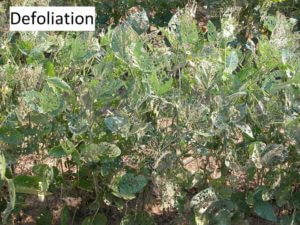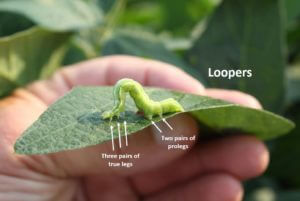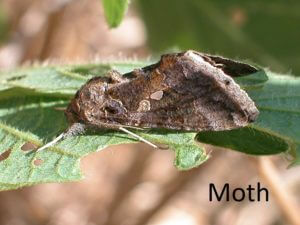Management options
| Insecticide (Trade Names) for LOOPERS | Lb Active Ingredient per Acre | Amount Formulation per Acre | Performance Rating Soybean/ Cabbage |
|---|---|---|---|
| chlorantraniliprole (Vantacor 5 SC) | 0.047 - 0.067 | 1.2 - 1.71 oz | 8/9 |
| chlorantraniliprole, bifenthrin (Elevest) | See label | 5.6 - 9.6 oz | 8/9 |
| chlorantraniliprole, λ-cyhalothrin (Besiege) | See label | 10 oz | 8/9 |
| indoxacarb (Steward 1.25) | 0.055 - 0.11 | 5.6 - 11.3 oz | 8/9 |
| methoxyfenozide (Intrepid 2) | 0.063 - 0.125 | 4 - 8 oz | 8/9 |
| spinetoram (Radiant SC 1) | 0.016 - 0.031 | 2 - 4 oz | 8/9 |
| spinetoram, methoxyfenozide (Intrepid Edge) | See label | 4 - 6.4 oz | 9/9 |
| spinosad (Blackhawk 36% WDG) | 0.034 - 0.05 | 1.1 - 2.2 oz | 8/9 |
- Late maturing varieties are much more likely to be infested with soybean loopers.
- Soybean looper is more difficult to control with insecticides than the cabbage looper. Although many pyrethroid insecticides are labeled for soybean looper control, they are not recommended because resistance is well documented. Indeed, use of pyrethroid insecticides can worsen infestations of soybean looper.
- Soybean loopers often, but not always, have black true legs (those behind the head) and/or black spots on the bodies.
- Treatable infestations of loopers prior to August, although uncommon, are likely to be cabbage looper and can often be controlled with pyrethroid or other insecticides. It is generally best to assume late season infestations are composed mostly of soybean looper and to use the recommended insecticides listed above.
- Do not confuse loopers (2 pairs of prolegs) with green cloverworm (3 pairs), which are easier to control with insecticides.
- For more information see https://extension.tennessee.edu/publications/Documents/W199.pdf.




